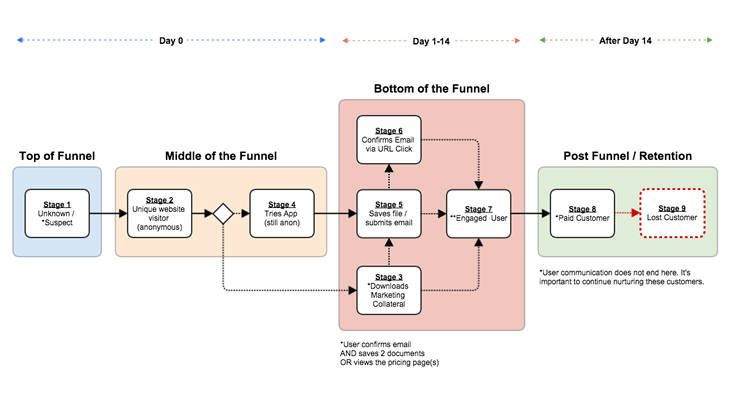Lead tracking is the process of documenting and categorizing prospective customers based on individual actions and sales rep touches. By documenting customer and account-related actions, you can pinpoint prospects at each stage of your funnel or sales pipeline.
ALSO READ: 7 Sales Analytics Tools for Driving Revenue Growth
Lead tracking provides data on individual prospects’ likelihood to close and the volume of leads at each stage of sales development. By tracking leads from initial touch to close, you’ll come to a better understanding of your campaigns, your funnel, and your sales and marketing process as a whole.
Lead Tracking vs. Lead Scoring
Lead tracking is basically the process of following a lead through the pipeline, including movement toward and away from closing and any action or inaction on the part of the lead. Lead scoring, on the other hand, is the act of assigning a positive or negative score to a lead once an action is taken. Every time a lead interacts with your brand, they should receive a score. The higher the score, the more qualified the lead.
Scoring is an essential part of lead tracking: every recordable action a customer takes and any touch a rep makes with the lead should trigger the addition or deduction of points from their score. When a new prospect downloads a whitepaper about the implementation process, for example, their score should go up, based on potential willingness to purchase. When that same prospect then clicks your emailed link to content, the score should rise again, reflecting further interest. At some point, a lead’s score will reach your predetermined threshold and trigger a follow-up from sales.
It’s important to understand both tactics, as a lead’s individual scores can help you track their progress toward close. Keeping an eye on this progress will help your sales and marketing teams gain valuable insights into campaigns and continue to hone their strategy.
Campaign-Critical Tactics
Personalization
The whole world is screaming “Personalize!” but never actually tells us how to do this at scale. It’s not just about entering markup into your drip emails ( i.e. Dear %NAME%, Thank you for downloading %whitepaper-name%). True personalization means offering value to the lead based on their level of interest. This is impossible to do without some form of lead tracking in place.

By updating leads as they interact with your brand, you can offer unique campaign items based on each stage the lead moves through. To do this, you will need to tag your leads according to actions: demos, phone calls, emails opened, downloads, anything that’s an important milestone on the funnel.
Some marketers find that building flow charts of expected lead behavior (including positive, negative, and no action) helps them visualize the movement of a lead along the pipeline.
Plugging Leaks in the Funnel
Lead tracking is the first step to understanding where your carefully crafted, highly personalized funnel breaks down. Are people downloading the whitepaper, but not signing up for demos? Perhaps you need to warm up those prospects a little more before you go for the big ask.
Without lead tracking, your team can’t tell what actions cause leads to bounce and which touches turn into closed-won deals.
Lead Scoring
Again, lead scoring is an essential part of lead tracking. It’s also a valuable tool for analyzing and adjusting campaigns. You should try to use the data you gain from lead tracking to improve how accurately your scoring framework reflects actual lead intent. E.g. if a batch of your leads have high scores, but your conversion rates are still low, you may be assigning too many points for individual actions.

By tracking your leads through the funnel and quantifying their behaviors, you can see where they fall off and what kind of engagement shortens the sales cycle. From there, you can test using those touches earlier, refine your nurturing process, and speed time-to-close in a provable way (rather than just guessing that your strategy works).
Get Set for Lead Tracking Success
Lead tracking doesn’t happen overnight. It takes a lot of planning and access to the right technology. Use the elements below to set yourself up for success. These steps will give your team important insight into where your leads are coming from and how they connect with your brand.
- UTM tags: If you don’t know what these are or how to use them, you’re missing out on a lot of valuable referral and campaign information. UTM parameters can be added to any base URL to track where a lead finds your brand. This helps you understand what content converts, and what content stays hidden.
- A full-funnel review: Your team should do this consistently as part of your test and iterate process. A full-funnel review helps define which stage of the buyer’s journey each of your marketing and sales assets serve, and the goal of each touch. Without defining your journey/funnel/pipeline, you risk going for a close too early or too late, which only ends in customer alienation.
- Flow charts: These handy visuals map out the buyer’s journey and any potential actions the buyer could take. At every touch, the buyer can either interact or ignore your message, and your team should map out its next move before the buyer ever gets there. The flow chart should inform your lead scoring decisions, which then inform your lead tracking, which in turn affect the architecture of your future flow charts.

- Marketing Automation Software: Marketing automation tools aggregate valuable interaction data and report that back to you. These insights will help you analyze your funnel, your lead scoring, and your lead tracking. Many of these tools also have built-in flow charts, funnel visualizations, and lead scoring tools to help your team manage more work from a single system.
- CRM: Another must-have for any B2B company. Rather than using a flurry of spreadsheets and sticky notes to orchestrate the sales process, CRM software lets your team track all of their interactions with a potential customer and automate repetitive tasks. If you can integrate your CRM and marketing automation tool, sales can access even more lead intelligence and report marketing-attributed revenue.
* * *
Companies that track their leads down (and out) of the funnel gain valuable insight into how their tactics affect or don’t affect outcomes. Without a defined and designed system of lead tracking, your team is in danger of marketing and selling based on gut feeling, rather than hard data.





